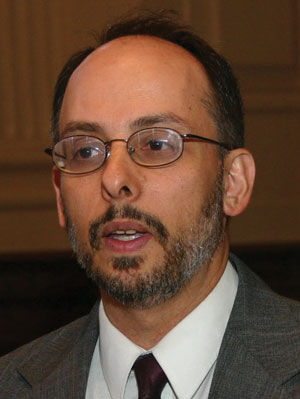Cartoons illustrate, educate about the Holocaust
Published April 27, 2017
Before he drew Horton the elephant faithfully hatching an egg, Dr. Seuss drew cartoons about Adolf Hitler and the deadly threat his Third Reich posed to the Jews of Europe.
Appearing in the now-defunct New York newspaper PM, Seuss — aka Theodor Geisel — was one of a few American cartoonists calling attention to the Holocaust, to alert the public about the genocide occurring in the concentration camps (Geisel was not Jewish).
Rafael Medoff, who co-authored the book “Cartoonists Against the Holocaust,” said in an interview that it may seem jarring to talk about the deaths of 6 million Jews in the same context as a medium usually connected with humor. But, he said, cartoons are an effective way to educate a generation that needs to learn more about Hitler and his drive to exterminate Jews.
Teachers agree that the method works well, Medoff said, adding that in 35 states, education about the Holocaust or genocide is required either by law or by decisions of local school boards. Classics such as the “Diary of Anne Frank” are good ways to get those lessons across, Medoff said, but teachers should also use fresh, different angles to engage their students.
“There was a debate over whether or not it was appropriate to use cartooning, which is normally associated with humor or with superheroes, to talk about the Holocaust,” he said. “But that debate was settled long ago.
“For young people in particular, visual images are very important means of education. You can hand a high school or college student a 300-page history textbook and ask them to read it, but you can’t expect that they’re going to remember a lot of it. And I say that as an author of a lot of 300-page history texts. But if you show them a historical cartoon, it will make an impact that ordinary textbooks will not.”
The use of cartoons about the Holocaust might be best known from the books “Maus” and “Maus II” by Art Spiegelman, who was honored with the Pulitzer Prize. Medoff and Spiegelman have worked together on a graphic version of the story of the MS St. Louis, the ship that was carrying 900 Jewish refugees from Germany in 1939 and was forced to turn back from the United States.
Earlier this year, Medoff worked with illustrator Dean Motter to tell the story of Japanese internment camps in the United States during World War II. The piece featured the family of George Takei, who went on to gain fame in “Star Trek.”
Such projects, Medoff said, are crucial ways to teach today’s youth about episodes in history that don’t always get the attention they deserve.
“Holocaust education has always been important and still is important,” he said. “Lessons from 1930s and ’40s can help inform us today and hopefully lead to young people creating a better world tomorrow. They are this country’s future leaders, so it’s important they learn how America responded to the plight of Jews and the Holocaust and also learn about the internment of Japanese Americans.”
Medoff said the focus on American political cartoons during World War II also helps set straight the historical record.
“There’s the notion that Americans didn’t really know what was happening to Jews until we liberated the camps in 1945,” he said. “When you look at cartoonists drawing cartoons during the war, about what was happening to Jews, you see very clearly that in fact a great deal was known to the public.
“Cartoonists knew what was happening to Jews and were commenting on it in their particular way. It’s good that we are dispelling the misconception that we didn’t know.”
Email the author: [email protected].















